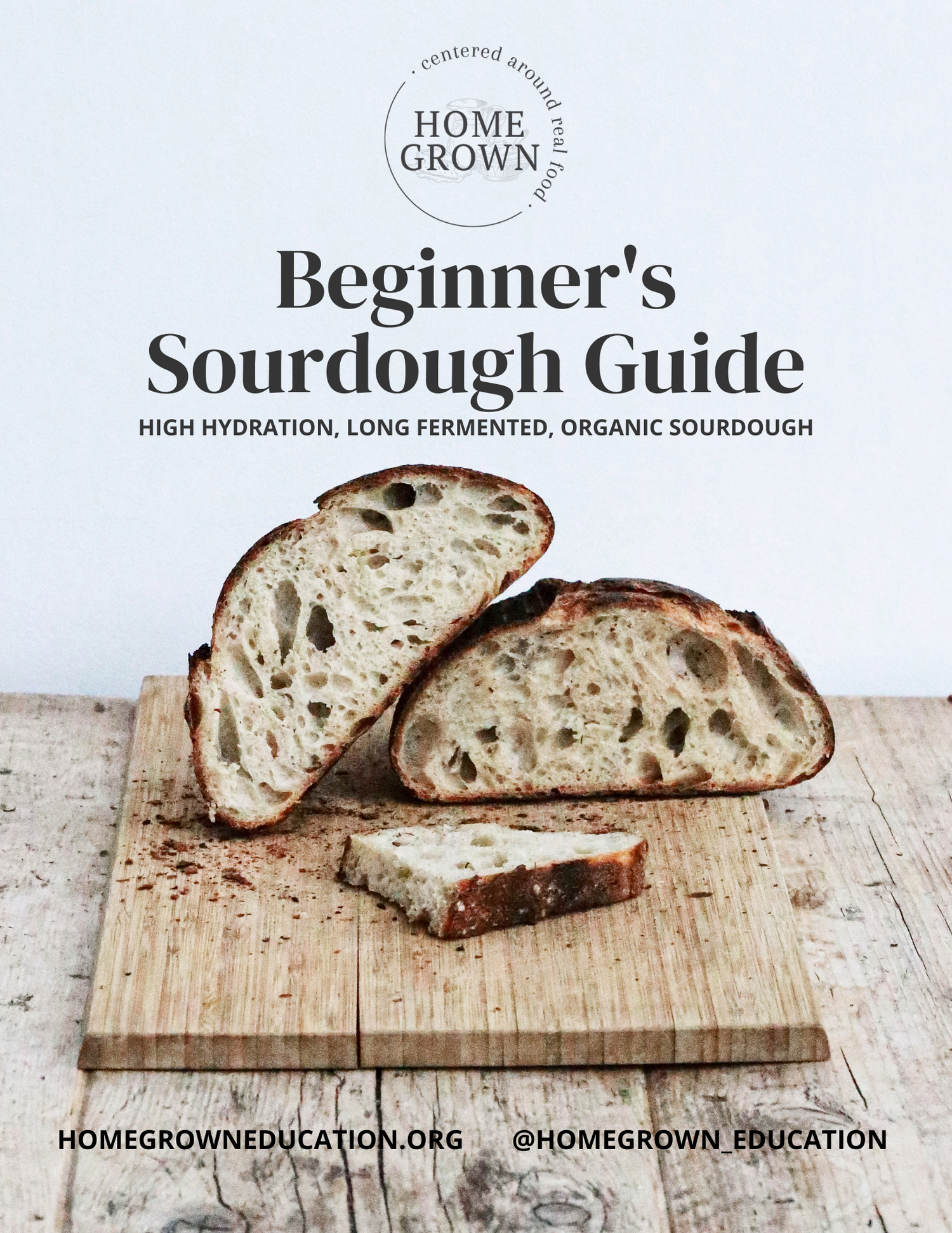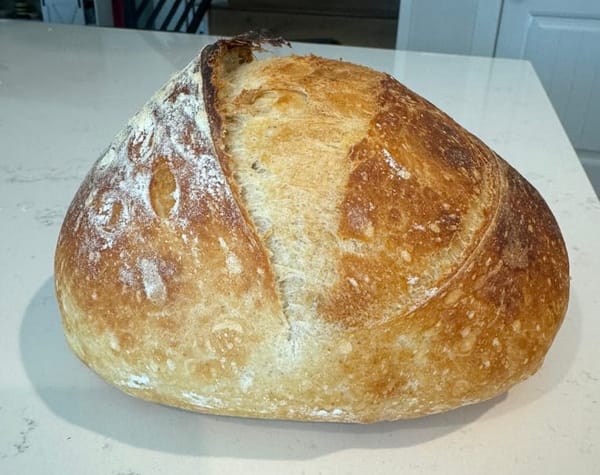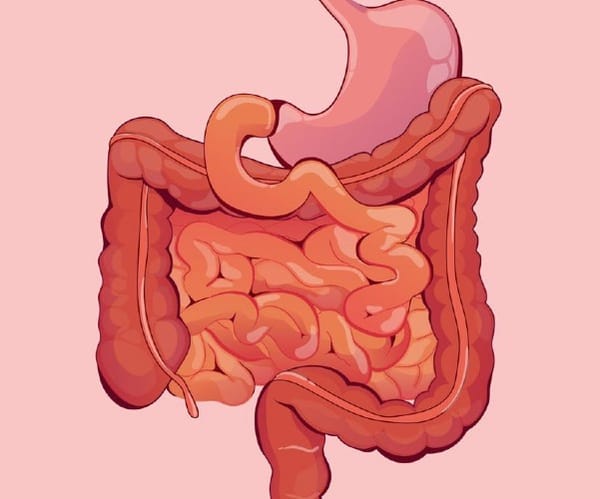How I'm Fixing My Gut Health

Introduction
After learning about the gut microbiome and its effect on the body, I realized that the microbiota in my gut was probably messed up BAD. Luckily, I was born vaginally and exclusively breast-fed for 6 weeks (thanks Mom), so I have that going for me… but what I’ve been feeding my microbes for the past 20 years has definitely caused some disruption. I now understand that the multiple antibiotic prescriptions per year paired with frequent fast food and sugar intake were big contributors to the inflammation I was experiencing in the form of bloating, acne, and fatigue.
With that being said, the gut microbiome is extremely adaptable. It will react to the environment that its host creates - either positively or negatively. The shift from a dysbiosis to symbiosis takes time, but can be achieved through gradually implementing diet and lifestyle changes. In this post I want to share what I’ve learned about habits that promote microbiome health and how I’ve implemented them into my everyday life.
Eat More Plant-Based Fiber
The best way to promote the growth of healthy bacteria and reduce leaky gut symptoms is by increasing intake of plant-based fiber in the form of fruits, vegetables, nuts, and seeds. These plant fibers that are indigestible by human enzymes are the #1 food of choice for the healthy bacteria living in your gut. Not to mention, breakdown of fiber by microbes leads to the production of short chain fatty acids that help seal the intestinal lining and prevent toxins from seeping into the bloodstream… ultimately reducing inflammation.
Another important thing to note about plant fiber is its key role in reducing glucose and insulin spikes. When you eat fiber with a meal, it slows the process of digestion and therefore slows the rate at which carbohydrates and sugars are absorbed into the bloodstream. This prevents that “glucose spike” or “sugar rush” that you might’ve heard about before. Without fiber, these spikes in blood glucose ultimately lead to a huge crash later in the day, which is usually characterized by extreme fatigue and sugar cravings. Lastly, the slowed emptying of glucose into the bloodstream allows more time for our cells to use it for energy before it is deemed “unnecessary” and shipped off to be stored in fat cells.
Clearly, plant fibers are extremely beneficial. Over the past couple months I have significantly increased my intake of fiber rich foods and have seen the pay-off in the form of more consistent bowel movements, increased energy levels throughout the day, and fewer stomach aches. Here are some tips and tricks that I’ve learned along the way.
- Eat fiber with every meal
I know this sounds like a big ask, but you’ll find that it’s easier than you think considering there are so many sources of fiber. Some of my favorites include:
- Green leafy vegetables
- Sweet potatoes
- Avocado
- Raspberries, blueberries, blackberries
- High quality whole-grain products
- Chia seeds, pumpkin seeds, flax seeds
- Almonds, walnuts, pistachios
The list goes on and on, but if you find a few good sources of fiber that you like, it becomes very easy to incorporate them into every meal. For example, I usually add avocado to most of my meals, and I try to sprinkle some sort of nut or seed into my smoothies and yogurt bowls.
- Try to eat the fiber first if you can
Eating plant fiber in any capacity is great for feeding your gut microbiota, but it doesn’t do much good for your blood sugar levels if you eat the fiber after you’ve already downed a pint of ice cream. When it’s convenient for you, think about eating your fruits and vegetables before other carbohydrates so you can reap the benefits of slowed digestion and a decreased glucose spike. I try to implement this hack by eating some sort of salad before my main meal, or sometimes I’ll just eat a handful of nuts if I’m lazy. Again, I’m not saying you have to do this every single time you eat because it’s not always convenient, but if you’re able to, eating your fiber first is a great way to reduce blood sugar and curb cravings later in the day. Next time you plan on eating something high in simple carbohydrates or sugars, try eating some fiber first and see how you feel afterwards.
Eat More Fermented Foods
First I want to provide a definition of a fermented food because I know it can be confusing.
Fermentation is a process in which microorganisms like yeast and bacteria break down carbohydrates into other products like organic acids, gases, and alcohol.
Fermentation usually involves combining a carbohydrate with water and salt in an airtight container and leaving it at room temperature for anywhere between a few hours to a few weeks to allow time for bacteria and yeast to break down the carbs. The most common fermented foods include:
- Sauerkraut
- Kimchi
- Cultured Yogurt
- Sourdough Bread
- Kefir
- Miso
High quality fermented foods are an excellent source of probiotics because they contain live cultures of bacteria. Consuming these foods regularly can promote increased strength and diversity of your gut microbiome. The nutrients in fermented foods are also more accessible than nutrients in “raw” foods. Take a carrot for example. The enzymes in our small intestine have to work harder to break down and absorb the nutrients in a raw carrot because they’re doing all of the work on their own. On the other hand, a fermented carrot has already been broken down to some extent by bacteria and yeast during the fermentation process, leading to more readily available nutrients for our enzymes to digest and absorb. Essentially, the bacteria and yeast have already done some of the work for our enzymes during fermentation, which makes nutrient absorption more effective and efficient.
Over the past couple months, I have been trying to eat some sort of fermented food every day to strengthen my microbiome with more beneficial bacteria. Here are some of the recipes I’ve been using to make fermented foods that I actually enjoy eating.
- Sauerkraut
Sauerkraut is one of the easiest fermented foods to make. I watched this video by Joshua Weissman to learn how to make it. It only takes 20 minutes of hands-on work and the rest is waiting patiently for the microbes to work their magic. I really like the taste of sauerkraut so I usually eat 3-4 spoonfuls with lunch or sometimes as an afternoon snack.
- Sourdough Bread
Not only is sourdough a probiotic, but the fermentation process required to make true sourdough products actually breaks down some of the gluten content, so it’s much easier on the digestive system. I LOVE to make homemade sourdough bread and other sourdough products, but obviously not everyone has the time or desire to do that. If you want to eat sourdough but don’t want to make it at home, I would recommend buying it from a local bakery or finding it at a farmer’s market.
Now that sourdough has become a trend, grocery stores are starting to sell sourdough products that look enticing, but if you read the ingredient list, you will see that most of these products contain yeast and vinegar. This is not real sourdough bread, but rather conventional white bread with vinegar added to make it taste sour. True sourdough bread only requires three ingredients: water, flour and salt. If you are interested in making your own sourdough bread from scratch (I highly recommend it!), this free sourdough guide is great for beginner’s.

- Cultured Yogurt
Much like sourdough bread, not all yogurt is created equally. A lot of yogurts at the store are ultra-processed and have killed off all the beneficial bacterial cultures. On top of that, they likely contain added sugars, preservatives, and artificial flavorings. Therefore, it’s important to be picky when looking for yogurt because you want one that has live cultures and minimal sugar/additives. When reading a yogurt label check for:
- The words “live and active” cultures
- An LAC seal - a certification that verifies there are at least 100 million cultures/gram of product
- The specific names of cultures like Lactobacillus, Streptococcus, and Bifidobacterium
Here are a few cultured yogurt brands I would recommend:
I go back and forth between buying yogurt at the store and making my own at home. It sounds intimidating to make yogurt but I promise it’s super easy. All you need is a few spoonfuls of store-bought yogurt that has live cultures, or a pre-made packet of live cultures that can be bought online. Here is a good resource for learning how to make homemade yogurt!
Instead of using a starter culture I use about 3 tablespoons of store-bought yogurt. I also heard there’s a feature on InstaPot for making yogurt that is super helpful, but obviously I can’t afford that. Mine still turns out great though, and I love eating it in the morning with some berries or throwing it in a protein shake.
- Fermented Vegetables
Lastly, I’ve been experimenting with fermenting a variety of raw vegetables like carrots, peppers, garlic, and cucumbers. Eating raw vegetables is still highly beneficial because of their fiber content, but the fermentation process offers additional benefits like probiotics and increased availability of nutrients. Again all you need are your vegetable of choice, water, salt, some spices, and 1-2 weeks of patience before ending up with the perfect fermented snack.
I often throw my fermented vegetables in a salad to add a salty flavor, but I also eat them straight out of the jar. The Cultured Guru has some amazing fermented vegetable recipes if you want to give it a try.

Limit Processed Foods and Sugar
Before becoming more interested in my health, I ate a lot of processed foods. I believed in the calories in vs. calories out concept, and thought that all calories had the same effect on the body. Since I was burning a lot of calories playing soccer and doing other activities, I assumed I had the freedom to eat whatever I wanted and everything would be fine. During my high school and college years I ate fast food 5-6 times a week, extremely processed snack foods daily, and sugary coffees or desserts every other day. I never gained weight because I was so active, but looking back I realize that my poor food choices were wrecking my gut microbiome and causing many other issues that I just accepted as “normal” for teenage girls.
I’m not saying that you should never eat processed foods. Obviously anything in moderation is okay, but consistent consumption of overly processed foods leads to the following negative impacts on your gut health:
- Feeding the Bad Bacteria
Just as the beneficial bacteria in our guts prefer plant fiber as their main food source, the harmful bacteria living in our guts love to eat sugar. The more sugar we eat, the more energy we give the harmful bacteria to grow and multiply, and the more imbalanced our gut microbiome becomes. If you eat excess sugar consistently enough over a long period of time, eventually the harmful bacteria will crowd out any of the beneficial bacteria you might have had, leaving you with a non-functioning microbiome.
- Fostering Leaky Gut and Inflammation
The standard American diet is high in processed foods and sugar, but low in fiber and fermented foods. With a diet like that, the friendly microbes that produce mucus and short chain fatty acids to protect our intestinal barrier are very likely depleted. Therefore, the one-cell-thick epithelial lining of the intestines becomes extremely permeable and lets toxins into the bloodstream. This constant flow of toxins into the body results in a constant inflammatory response from the immune system. It’s a vicious cycle that can only be escaped by feeding your protective bacteria what it wants (plant fiber) and limiting what the harmful bacteria want (sugar and processed foods).
- Blood Sugar Spikes
I know I already touched on blood sugar spikes but I want to point out how pronounced they become when we eat processed foods instead of real foods. Technically any food that has carbohydrates will give you a glucose spike to some extent, but the glucose spike you get from a handful of blueberries is not the same as the glucose spike you get from a brown sugar cinnamon pop tart. Although the blueberries contain glucose, they also contain fiber and other nutrients that are beneficial for our bodies, so the digestion time is slower and the glucose spike is more gradual. On the other hand, I’m not even sure if you can call a pop tart food because it contains nothing of value for our human cells or our microbial cells. Since there is practically nothing to digest, the sugar from the pop tart shoots straight into the bloodstream and causes a drastic spike in blood glucose. If that glucose isn’t used for energy almost immediately, it will be stored in fat cells. This is just another example of the fact that calories are not created equally.
I still eat fast food and other processed foods every once and awhile, but now I’m aware of their effects on my gut health and realize that the calories from a Caniac Combo aren’t the same as the calories from a homemade salmon caesar salad. Viewing processed foods as an occasional treat rather than a sustainable energy source is a key step in improving your gut microbiome and overall health. Here are some guidelines I try to hold myself to when it comes to processed foods and sugar:
- Eat out only 1-2 times per week
- Only 1 coffee shop drink per week
- Eat something high in fiber before eating something high in sugar
- Don’t keep processed snacks in the house
Fix Your Gut
If you want to know exactly where your gut microbiome health stands, you can send a stool sample to a functional medicine doctor and they can tell you specifically which strands of bacteria populate your large intestine. If the results are scary, they will prescribe you a low dose of antibiotics to clear out your dysbiotic gut microbiome and essentially leave you with a clean slate to foster a healthy community of microbes. Like the InstaPot, I simply cannot afford to have this test done at the moment, so I’m going to stick with more accessible remedies like eating more plant fiber and fermented foods while limiting processed foods and sugar. I can already see a huge difference in my health even after a few months of implementing these diet changes. I no longer get bloated after meals, I don’t experience the dreaded mid-afternoon energy crash anymore, and my IBS symptoms are practically gone. However, I would like to get my microbiome analyzed eventually just to see what I have going on in there!
Typical Day of Eating For Me
To end, I want to share what a typical day of eating looks like for me while trying to improve the health of my gut microbiome. Hopefully it can paint a better picture of how to implement fiber and fermented foods throughout the day. I have not forgotten that proteins and fats are essential for health and I do eat a lot of both - I just wanted the focus of this post to be on food groups that specifically benefit the microbiome.
Breakfast: I usually eat an egg scramble with some ground protein, sauteed veggies, avocado, and shredded parmesan cheese. On the side I like to add cultured yogurt with berries, chia seeds, and a drizzle of honey.
Lunch: For lunch I either start with a platter of veggies dipped in homemade pesto or a small salad with some fermented veggies mixed in. Then I’ll have 2 hard boiled eggs that I sometimes mix into egg salad with homemade olive oil mayonnaise and serve on a slice of sourdough bread. I top it off with a piece of fruit, usually an apple or an orange.
Dinner: Dinner varies a lot for me but I typically stick to the basics of having veggies, protein, and some sort of traditional carbohydrate (that’s not a vegetable or fruit). It’s pretty much a mix and match depending on what I have in my fridge at the time, but I like to think of having half my plate filled with veggies, and the other half split between the protein and carbohydrate. Here are some examples of foods that I like to incorporate throughout the week:
- Veggies: Asparagus, cauliflower, broccolini, mushrooms, arugula, romaine, sweet onion, tomatoes (sometimes I roast the veggies and sometimes I throw them in a salad)
- Protein: Steak, meatballs, salmon, chicken breast, or chicken thigh
- Carbohydrate: Sweet potatoes, russet potatoes, jasmine rice, spaghetti squash, or sourdough bread
Snacks: My meals generally keep me pretty full, so I don’t experience sugar cravings throughout the day, but if I’m in one of those funks where I just can’t stop eating, I like to snack on sauerkraut, berries, homemade sourdough crackers, or throw together a quick protein shake. For the protein shake I use frozen blueberries and bananas, pea protein powder, creatine, L-theanine powder, a few spoonfuls of yogurt, milk, and chia seeds or flax seeds for added fiber.
Dessert: I’m not going to lie, I still go out and get ice cream probably once a week… which is totally fine because it’s always after I’ve eaten a meal high in fiber and other essential nutrients. Plus, it’s sort of a tradition in our house and I think it’s fun. Other than that I don’t really eat desserts because I don’t get those sugar cravings right before bed like I used to. On nights when I really feel like eating something sweet after dinner, I’ll make a yogurt bowl with berries and honey, slap some almond butter and chocolate chips on a date, or just toast up a piece of sourdough and top it with butter and honey.
Fuel Your Microbiome
I am by no means a dietician or an expert on the gut microbiome, these are just some lifestyle changes I’ve implemented after doing extensive and listening to some really smart people. I don’t have any proof in the form of labs or tests that my gut health is improving or my inflammation markers are down, but there is no doubt that I feel healthier, which was my ultimate goal when I started this journey in the first place.
Hopefully after reading my last two posts you have a better understanding of:
- What the gut microbiome is and its role in overall health
- What a healthy microbiome likes to eat
With this new knowledge, try to think about eating not only as fueling yourself, but also the 10 trillion microbes living in your gut.
Thanks for reading!
Recommended Resources
The Good Gut by Justin and Erica Sonnenburg





